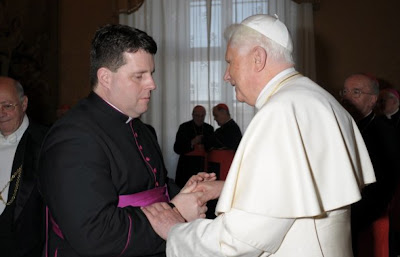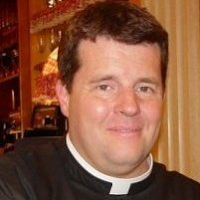I first discovered Monsignor Richard Soseman through Archbishop Fulton J. Sheen. I’ve been a huge Sheen disciple ever since I became Catholic, in part because of my “Sheen-fiend” spiritual director, but also through studying his work myself.
That meant I was thrilled when a new DVD came out a couple years ago titled Archbishop Fulton Sheen: A Servant of All, which explored Sheen’s whole life: from the farmlands of Peoria, IL to his great media success, to his prolific writing, preaching, and episcopacy.
In the film, a number of people shared stories and anecdotes about Sheen, but I was particularly struck by a young monsignor who hailed from Sheen’s Illinois homeland and offered some great insights.
Fast forward a year, and I find myself at a rooftop party in Rome. We were a couple hundred yards from St. Peter’s Basilica, and to my surprise, in walks that same young monsignor, introducing himself as Msgr. Richard Soseman.
The two of us hit it off and spent much of the night chatting about Sheen, the Vatican, new media, and more. As our conversation winded down, Msgr. Soseman invited me to celebrate Mass with him the next morning at St. Peter’s–which had me bubbling with excitement.
The next morning we met at 7:00am inside St. Peter’s and celebrated Mass in a tiny chapel below St. Peter’s. We worshiped in front of a thousand year old fresco, mere feet from the bones of St. Peter (Msgr. Soseman later reflected on the experience.)
Besides being heavily involved in the canonization process for Archbishop Fulton Sheen, Msgr. Soseman currently works in the Vatican for the Congregation for the Clergy. He’s a fascinating man, and I’m glad we had a chance to chat. Enjoy!
Q: In your day job you work for the Congregation for the Clergy. What kind of responsibilities do you have there?
The Congregation for the Clergy was instituted after the Council of Trent (16th century), and its purview is rather wide. Its oversight is grouped into four different offices.
The first office oversees Diocesan Priests and Deacons. It covers everything involved with priests as they carry out their sacred ministry: parishes, church buildings, Mass stipends, the Year for Priests, etc. The second office oversees catechetics throughout the world. The third office oversees the patrimonial goods of the universal and diocesan Church such as real estate and retirement benefits. And the fourth office handles dispensations.
Officials of the Congregation–like me–study different matters, summarize them for the Superiors, and then offer possible solutions. Once a decision has been made by the Superiors, us Officials then prepare materials for mailing and wrap up the matter.
If that sounds somewhat confusing, you can learn more at the Congregation’s official website.
Q: You were born and raised in America, yet now you work in the Vatican. What are some of the biggest differences you’ve noticed?
Rome is a big city. Like any big city, it can be a bit much at times, especially for someone who grew up on an island in the Mississippi River. For example, people can be pushy in the street and shockingly aggressive while driving.
Most of the time, though, I interact with Romans who practice and treasure the Faith, and so I mostly encounter all of the best traits we know of Italians: their courteousness, kindness, culture, and true interest in others. Italy is a peninsula, which means these unique attitudes and customs have been preserved for a few thousands years.
In addition, religious practice by those who attend Church tends to be fervent and devotional, so I am energized by the number of Masses and Religious Processions I’m invited to.
Q: Anyone who lives and works in Rome is bound to have some wonderful stories—brush-ins with Church leaders, moving religious services, and more. What is one of your favorite experiences?
The closing of the Year for Priests was a very special time in my life, especially since we in the Congregation were sponsoring it. The closing ceremonies consisted of three days. The first two days included mornings at St. Paul Outside the Walls, with reflections offered by Cardinals, along with Eucharistic Adoration, Confessions, Benediction, and finally Holy Mass.
The turnout was astounding. So many priests signed up from throughout the world that St. Paul filled up, and so St. John Lateran was used simultaneously. It was such an inspiration seeing the basilicas filled with tens of thousands of priests from all over the world. The old hymn started “A Priestly Heart, the Sacred Heart,” and indeed, the closing day of the Year for Priests, on the Feast of the Sacred Heart, was extremely moving, with again, thousands of priests praying together, united in our common commitment to Jesus and to his Church.
Q: You hail from the diocese of Peoria, IL, which is perhaps most famous in the Catholic world for being the homeland of Archbishop Fulton Sheen. How has Sheen affected your own life and priesthood?
Bishop Daniel Jenky asked me to serve as the Judge for the Cause of Bishop Sheen, so it was my privilege to hear from hundreds of people who had been influenced by this great man of the Church.
Archbishop Sheen has made me very aware of the need to reach out and spread the Gospel through the means of developing media. Throughout my priesthood I’ve been involved in a Catholic section on Compuserve, then email groups, text messaging, and now Facebook.
Sheen exemplified how to use these new media tools to spread the Gospel, and to help people realize that religion is not arcane. It is not something to be kept on a high bookshelf and taken down only on Sunday, it is meant to be present in life–as present as the ubiquitous presence of new media.
Q: Right now, Sheen is in the process of canonization. Can you explain how the process works and where Sheen’s cause is right now?
A cause for beatification begins by gathering, at the local level, all manner of testimony from people who knew the candidate and people who were influenced to greater devotion because of him. It’s also the time to gather any historical documents from archives throughout the world, as well as collect and review all the books published by the particular Servant of God.
All of this material is then assembled and submitted to the Congregation for the Causes of Saints. For Archbishop Sheen, about 6,500 pages of testimonies and acts were submitted to the Holy See in 2008, and it appears to be progressing very well.
Q: Archbishop Sheen wrote scores of books and spoke for hours on television and radio. But what’s the biggest lesson he can teach the world today?
Archbishop Sheen has convinced me that the new media must be addressed with the New Evangelization, something you realize, Brandon, and very well I might say!
But his primary message for today, I think, would be the same as it was in his day: God loves YOU! God loves and values each one of us personally and individually. Archbishop Sheen combated the alienation and depersonalization he noted in the world, which reduced people to a number serving the state, or pigeonholed them into some convenient psychological category. When this happened, a person was seen not as a moral agent, but as a slave to his or her impulses.
Archbishop Sheen would remind us of the power of the Holy Spirit to work wonders–even today–and of the love that God has for each and every person.
His favorite phrase still rings true: God loves you!
Q: Last question: if you could recommend your top three, must-read books, what would they be?
My all-time favorite book is Kristin Lavransdatter by Sigrid Undset, so that would have to be listed.
But my three must-read books, in addition to the Bible, would first include the Introduction to the Devout Life by St. Francis de Sales. This is possibly the best guide for the spiritual life, so good and practical, indeed, that it was instantly translated even for Protestants in the contentious post-Reformation days. There are some versions which leave out some of St. Francis examples, but I find these to be very helpful.
Another recommendation is Don Quixote, by Cervantes. People say if you only read one book in your lifetime, it should be Don Quixote, and that you should read it in youth, in middle age, and in old age.
Finally, most recently I have found much good fruit in Archbishop Fulton Sheen’s Old Errors and New Labels, which shows that there are really no new errors under the sun, just new labels. Since the beginning of time, Archbishop Sheen notes, there have been two moral systems followed by men: the first to think the way we live, the second to live the way we think. This book helps us reflect on which of the two camps we fall into.
For more, check out Nancy Piccione’s interview with Msgr. Soseman, and be sure to follow him through Facebook or the Congregation for the Clergy’s official website.
If you liked this interview, check out my other discussions with people like Fr. Robert Barron, Christopher West, Bishop Christopher Coyne, Marc Barnes, Dr. Michael Barber, and Lisa Hendey.
And be sure you don’t miss future interviews by subscribing to The Thin Veil via RSS or email.
Have you ever been to Rome? Are you a fan of Archbishop Sheen? Let us know below!
(Image Credit: Nancy Piccione, God Love You)



